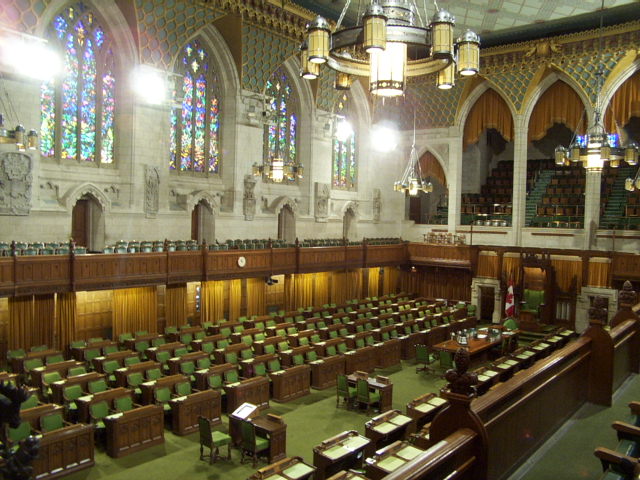Canada News
Will Parliament take steps to clarify medical assistance in dying law?

FILE: The Canadian House of Commons on Parliament Hill in Ottawa (Photo by Montrealais – Own work, CC BY-SA 3.0)
When the federal government introduced Canada’s medical assistance in dying legislation back in 2017, there was swift and fierce backlash against one of the eligibility criteria – a person’s natural death had to have become “reasonably foreseeable.” The government was told in no uncertain terms that the criterion was unconstitutional and unclear, but Parliament passed the legislation with the reasonably foreseeable criterion anyway. Unsurprisingly, Charter challenges to the legislation and confusion on the ground ensued.
In a September 2019 decision of the Quebec Superior Court in Truchon, Justice Christine Baudouin struck down the reasonably foreseeable requirement. She gave the government six months (later extended by four months because of the Fall election) to amend the legislation. The government decided not to appeal this decision and, in February 2020, Justice Minister David Lametti introduced Bill C-7 to amend Canada’s MAiD legislation.
Like so much else in our lives, COVID-19 put Bill C-7 on hold. However, as Justice Baudouin’s decision will take effect on July 11, 2020 (barring a further extension), Parliament has to turn its attention to Bill C-7 if it doesn’t want the “reasonably foreseeable” eligibility criterion for MAiD to disappear, with none of the procedural safeguards in place that the government is proposing. As they study the amendments, parliamentarians should ensure that the following happens:
Pass the proposed amendment that removes “reasonably foreseeable” as an eligibility criterion for MAiD.
This might seem redundant, since it has already been struck down in Truchon. However, the Attorney General of Canada has argued that the Truchon decision will only apply in Quebec. Case law, academic commentary, and even Justice Baudouin suggest that he is wrong about this. Still, Parliament should pass the amendment to provide certainty around the law in the rest of Canada, and remove the fear of potential criminal liability for medical and nurse practitioners outside Quebec.
Clear up the confusion about the meaning of “reasonably foreseeable.”
The proposed amendments actually keep “reasonably foreseeable” in the legislation – but it no longer is a determining factor in whether you can get MAiD or not. Rather, it determines which procedural track you must follow to get MAiD.
The proposed amendments establish a two-track approach for Canadians seeking medical assistance in dying. If someone’s natural death has not yet become reasonably foreseeable, they will face far more procedural safeguards than if someone’s natural death has become reasonably foreseeable.
For example, they will face a 90-day waiting period from the time they make their first request until MAiD is provided as opposed to no waiting period. They must be assessed by a practitioner with expertise in the condition causing the person’s suffering. They must have been offered consultations with relevant professionals who provide services to relieve their suffering. The medical or nurse practitioner with expertise in the person’s condition and the practitioner providing MAiD must agree that the person seeking MAiD has given serious consideration to the means of relieving the person’s suffering. None of these safeguards applies where a person’s natural death has become reasonably foreseeable.
What “reasonably foreseeable” means is therefore critically important. Bill C-7 does not include a definition of “reasonably foreseeable,” and the justice minister has sown some confusion around the term. When introducing Bill C-7, the Minister of Justice used the following phrase: “death that is expected in the relative near term.” The Preamble to C-7 refers to “dying persons.” But when subsequently asked for clarification about the meaning of “reasonably foreseeable” in C-7, the Minister of Justice gave the following written response to a journalist: “The definition of reasonable foreseeability of natural death has not changed in the new legislation. Reasonable foreseeability of natural death is a familiar concept for providers after four years of providing the service. By retaining the same language in Bill C-7, practitioners will be using a standard that is already familiar to them as a means to determine which safeguards to apply.”
Understanding the “standard that is already familiar to them [providers]” is therefore crucial.
Fortunately, it is possible to offer insight into that standard. We can look to widespread clinical practice, case law in Ontario, College of Physicians and Surgeons’ practice standard in Nova Scotia, uncontested expert testimony in a BC court case, and expert academic commentary. We can conclude that “reasonably foreseeable” does not mean “dying” or “death in the near term” but rather means temporal proximity (sufficiently soon) or a predictable path to death.
This means that the “reasonably foreseeable” criterion is met under the following illustrative circumstances:
- When an individual’s death is anticipated in the near or even not too remote future. For example, if someone is dying of cancer and expected to live only a year, their natural death is reasonably foreseeable.
- When an individual is on a predictable trajectory toward death. For example, if someone has received a diagnosis of ALS, Huntington’s disease, Parkinson’s disease or dementia and their ultimate path to death is now predictable, their natural death is reasonably foreseeable – even though their death may be some years away.
- When an individual expresses a clear intent to refuse treatment or preventive care to make their natural death soon or predictable. For example, if someone with a progressive degenerative disease were to indicate the intent to stop using a critical medical device or refused treatment for pneumonia, her natural death would be reasonably foreseeable.
The confusion caused by the mixed messaging should be cleared up by the minister. Canadians should not left to engage in painful exercises of statutory interpretation. He should state on the record in Parliament (through a statement in the House or when appearing before the Justice Committee as it considers Bill C-7) that “reasonably foreseeable” means what it has come to be understood to mean: “natural death will be sufficiently soon or that the patient’s cause of natural death has become predictable.”
Determine whether Bill C-7’s proposed additional procedural safeguards tied to reasonable foreseeability are Charter compliant and sound public policy.
This is the greatest challenge facing Parliament. Committees in both the House and the Senate will need to hear testimony from the justice and health ministers, senior bureaucrats, experts, and stakeholders. They will need to hear about the barriers to access to MAiD that these proposed new safeguards will present, the harms that will be caused by these barriers, and the harms that the safeguards are intended to protect against. If, through these hearings government officials cannot defend the limits they place on the Charter rights to life, liberty, and security of the person and the right to equality, then yet again they will find themselves back in court arguing about and trying to defend “reasonably foreseeable.” If they can, then the unfortunate saga of “reasonably foreseeable” can finally be put to rest.
Photo: Shutterstock/By WorldStock
This article first appeared on Policy Options and is republished here under a Creative Commons license.





















